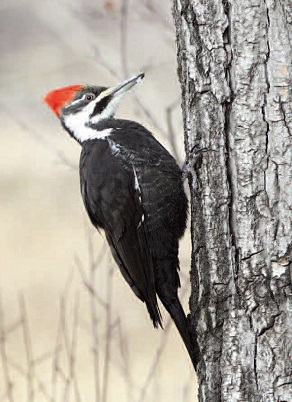Resurgence of the pileated woodpecker around us
 SCORES & OUTDOORS
SCORES & OUTDOORS
by Roland D. Hallee
A couple of weeks ago I received a phone call from a reader telling me about spotting a pileated woodpecker at her backyard feeders. For one thing, that is curious in itself because they are such isolated birds. They don’t like to to come out into the open. But what grabbed my interest in talking with this person was that she didn’t only see one, but three of them at one time.

pileated woodpecker
I had never heard of that.
She did follow that up by saying there was one smaller than the other two. So, logic would indicate two adults and a young.
We have had pileated woodpeckers at camp, but in the 28 years we’ve been there, I have seen one on only three occasions. And every time was by accident. I just happened to catch a glimpse of it in flight through the thickest part of the woods.
I did, however, see one a couple of years ago in my backyard in the middle of Waterville. I just happened to be looking out the kitchen window when I saw it perched on an apple tree stump. My first thought at the time was it was obviously lost.
Unlike the ivory-billed woodpeckers, which some people say are extinct, much to the chagrin of others, the pileated woodpecker has made a comeback following a period of decline in numbers. The pileated woodpecker is the second largest of the species, smaller than the ivory-billed. If they still exist, they are extremely rare, although authorities believe that reported sightings may be the mistaken identity of a pileated.
Numbers in the eastern United States declined sharply during the 18th and 19th centuries with the clearing of forests. However, since 1900, they have made a gradual comeback, becoming common in some areas.
The incubation period is about 18 days, with both sexes participating (with the males incubating at night and part of the day). Both parents feed the young by regurgitation. After about a month, the young are ready to fledge on their own. However, some young have been known to stay with the parents up to three months.
Pileated woodpeckers favor mature hardwood forests, but will inhabit smaller woodlots as long as they contain some taller trees.
They remain in their area all year round, and are not migratory. They defend their territory all season, but will tolerate others passing through during the winter.
Pileated woodpeckers are relatively long-lived, with the oldest known living almost 13 years. Predators include martens, weasels, squirrels, rat snakes, and gray foxes. Once they mature to full size, they have fewer predators, which include Cooper’s hawks, northern goshawks, red-tailed hawks, great-horned owls and barred owls.
Its ability to survive in many different wooded habitat has allowed the species to survive human habitation. Even though they do not migrate, they are protected under the U.S. Migratory Bird Act.
Despite the fact they control many insect populations, especially tree beetles, some people consider them a nuisance because of the harm they can inflict on trees.
Offering woodpeckers food in an environment in which they are comfortable and familiar is the best way to bring them out of the woods and into your yard. My wife has several feeders at our home, one with a buffet of different seeds and nuts, also spiced with cayenne pepper (to discourage the squirrels) which attracts many song birds. But we also have a steady showing of both hairy and downy woodpeckers. We have yet to see a pileated.
Responsible journalism is hard work!
It is also expensive!
If you enjoy reading The Town Line and the good news we bring you each week, would you consider a donation to help us continue the work we’re doing?
The Town Line is a 501(c)(3) nonprofit private foundation, and all donations are tax deductible under the Internal Revenue Service code.
To help, please visit our online donation page or mail a check payable to The Town Line, PO Box 89, South China, ME 04358. Your contribution is appreciated!


I really got interested in the plight of the Ivory Billed Woodpecker when I saw the film “GHOSTBIRD” in the middle of the night about 5 years ago. I have ever since been keeping a close watch of and have about 12 sightings of Pileated Woodpeckers. I live in the south central part of Virginia and there are many around this part of Virginia. My nephew saw 3 at one time while helping a friend move some furniture about 2 years ago. I have seen 2 at a time but never 3. I get up early some Saturday mornings to go look and listen for them. I hope one day someone gets proof that the Ivory Billed is not extinct.